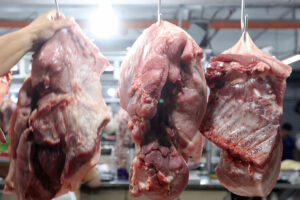AGRICULTURAL OUTPUT grew by an annual 1.9% in the first quarter, as good weather helped boost crops, fisheries and poultry production, the Philippine Statistics Authority (PSA) said.
Data from the PSA showed the value of agriculture and fisheries production rose by 1.9% in the January-to-March period to P437.74 billion, faster than 0.2% in the first quarter of 2024.
This was a turnaround from the revised 2% contraction in the fourth quarter and ended three quarters of decline.
“The value of crops, poultry, and fisheries production recorded improvements, while livestock continued to decline during the quarter,” the PSA said in a report, citing constant 2018 prices.
At current prices, the value of production in agriculture and fisheries rose by 2.3% in the first quarter to P623.66 billion.
“We are optimistic that the recovery in the first quarter signals momentum for the latter half of the year — especially as we bring new infrastructure online such as cold storage facilities and rice processing systems,” Agriculture Secretary Francisco Tiu Laurel, Jr. said in a statement.
However, former Agriculture Undersecretary Fermin D. Adriano said the first-quarter agricultural output results were “expected.”
“(This follows the) normal pattern of agri performance for first quarter of the year given the absence of typhoons and extreme weather occurrences… The harvest season extends in the first quarter of the year. Wait till the second quarter, which is planting (lean supply) season for rice and intense heat affects water supply for irrigation,” he said in a Viber message.
Crop production, which accounted for 57% of the total, increased by 1% to P249.61 billion in the January-to-March period. This was a turnaround from the 0.3% decline in the same period last year.
Palay or unmilled rice production inched up by 0.3%, an improvement from the 2% contraction a year ago.
The volume of palay production went up to 4.7 million metric tons (MMT) in the period ending March from 4.69 million MMT in the same period last year.
The Department of Agriculture (DA) said that yield reached a record high of 4.09 MT per hectare, offsetting the decline in rice-planted areas. It targets a record palay output of 20.46 MMT this year.
PSA data showed corn production declined by 5.1% in the first quarter, a reversal of the 0.5% growth last year.
Coconut output slipped by 0.3%, slower than the 3.3% decline in the same quarter in 2024.
Crops that saw a double-digit increase in the value of output include tobacco (80.4%), cacao (23.6%), sugarcane (19%), rubber (13.6%), coffee (10.7%) and mongo (10.1%).
On the other hand, the value of production contracted for abaca (15.4%), sweet potato (9.4%), mango (7.5%), cabbage (6.4%) and calamansi (0.8%).
PSA data showed the poultry sector grew by 9.4% to P75.22 billion, contributing 17.2% to total farm production.
The value of chicken egg production rose by 12.1%, while chicken output increased by 8.7% and duck by 1.5%.
On the other hand, duck egg production declined by 2.2% in the first quarter.
“We can see a little shift in the consumption pattern of consumers to the poultry sector as a source of food protein due to higher prices of meat, especially of hogs,” Philippine Chamber of Agriculture and Food, Inc. President Danilo V. Fausto said in a Viber message.
“This can be seen in the good performance of chicken and egg production and decrease in growth of the hog sector,” he added.
However, Mr. Fausto warned the local poultry industry may face challenges if there are increased imports from the US.
“The poultry sector will experience headwinds, however, if the US will require the entry of more chicken to the country as a bargaining chip to reconsider the tariff imposed by Trump for Philippine exports to the US,” he said.
SLUMP IN LIVESTOCKMeanwhile, the value of livestock production continued to decline in the first quarter.
PSA data showed livestock output slipped by 2.8% to P57.82 billion in the period ending March, although the pace of decline was slower than 3.5% in the same quarter last year. This accounted for 13.2% of the total farm output.
Hog production slumped by 3.7% in the first quarter, while carabao output dipped by 0.2%.
However, an increase in production was seen in dairy (10.5%), cattle (1.3%), and goat (1.2%).
“Livestock contraction is expected as the much-vaunted ASF (African Swine Fever) vaccine of the DA is ineffective with little adoption by hog raisers,” Mr. Adriano said.
The DA in March said it was expecting the approval of the Food and Drug Administration by April for the commercial rollout of ASF vaccines from Vietnam.
“Hopefully, we could also begin later this year the commercial roll out of the long-awaited vaccine for ASF, which will help kickstart the DA’s a large-scale hog repopulation effort,” Mr. Laurel said.
Bureau of Animal Industry data as of April 11 showed ASF had been detected in 54 villages, up from 39 as of March 14.
Meanwhile, fishery production rose by 1.5% to P55.1 billion in the first quarter, accounting for 12.6% of the total output. This was an improvement from the 0.2% drop in the same period in 2024.
Milkfish (bangus) production rose by 7.8%, while tilapia inched up by 2.2%.
Double-digit growth was seen for slipmouth or sapsap (21%), mudcrab or alimango (20%), Indian mackerel or alumahan (14.5%) and blue crab or alimasag (12.1%).
However, declines were seen for fimbriated sardines or tunsoy (34.5%), roundscad or galunggong (14.7%), cavalla or talakitok (12.7%) and bigeye tuna or tambakol (11.2%).
Raul Q. Montemayor of the Federation of Free Farmers said the agriculture sector still has a lot of catching up to do, especially since output declined last year.
In 2024, farm output shrank by 2.2%, due in large part to the El Niño weather pattern, which is estimated to have caused about P15-billion in damage to local agriculture. — K.A.T.Atienza






